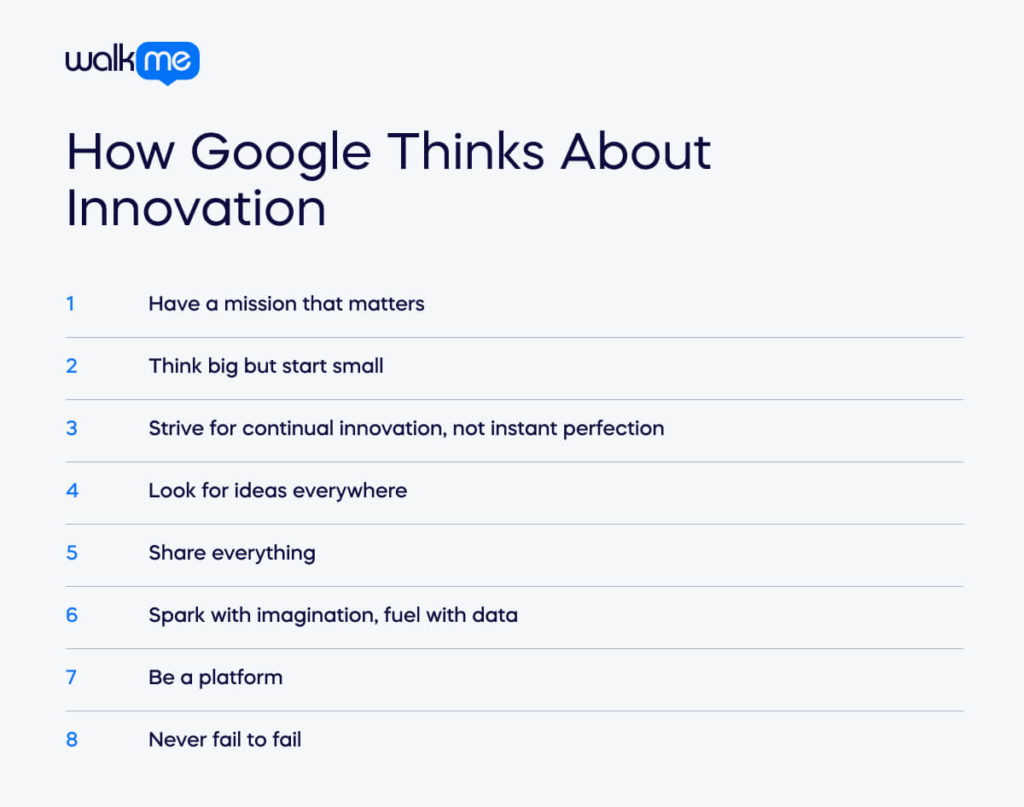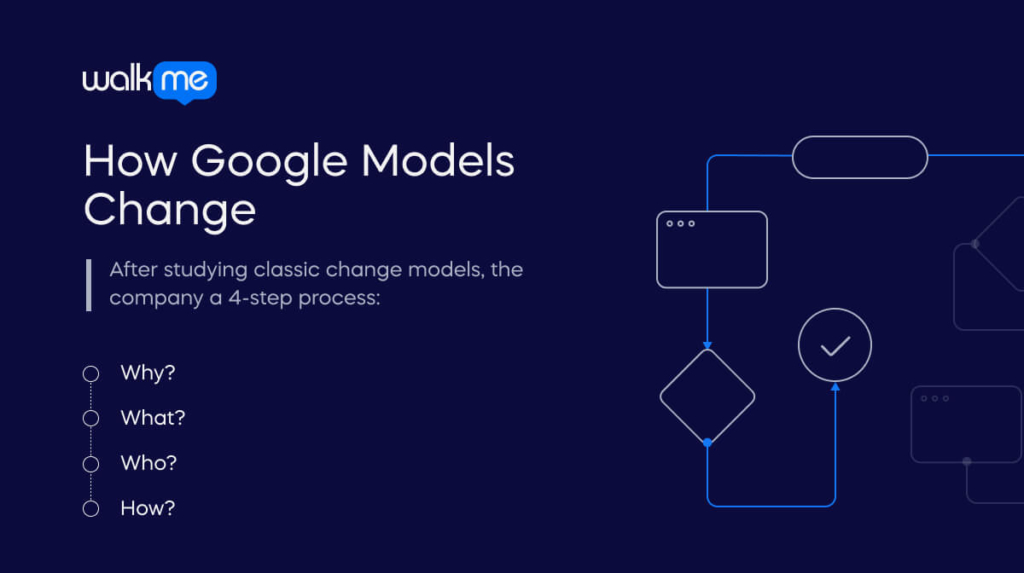Google models change, change management, and innovation in ways that fit with the digital age.
Like most other modern companies, Google understands the need for innovation, adaptation, and evolution.
After all, companies that don’t evolve, don’t survive.
Digital technology continues to drive innovation, competition, and the global economy.
To thrive in today’s marketplace, companies must evolve to survive, which makes change management more important than ever.
Below, we’ll look at how Google views innovation … and how it manages the change that results.
How Google Thinks About Innovation

YouTube’s Susan Wojcicki wrote about innovation for Think with Google, detailing her thoughts on innovation.
In her article, she outlined 8 pillars of innovation—ideas that any organization should internalize if it wants to adapt to today’s fast-paced digital marketplace.
- Have a mission that matters—As she says, “work can be more than a job” when you care about your work. Google’s mission is to “organize the world’s information,” touching people’s lives around the globe.
- Think big but start small – No global company began as a global company. Whether you start in a garage or in a funding round, it’s important to start at your current level while never losing sight of the end vision.
- Strive for continual innovation, not instant perfection. Wojcicki stresses iteration as a key to success rather than a waterfall approach. Today, many modes of thought, such as kaizen, lean, and agile, are built around continual improvement and iteration.
- Look for ideas everywhere. Ideas can be found anywhere, at any time. She relates stories of how problems have been solved by posting handwritten notes on idea boards and during snack breaks in “microkitchens.”
- Share everything—Sharing, discussion, and re-interpretation of ideas are encouraged. This process can lead to innovative solutions that would never have occurred if information stayed siloed and discussion was discouraged.
- Spark with imagination, fuel with data—One way to actively promote innovation is through what Wojcicki calls “20 percent time,” a full weekday during which engineers can work on whatever they want. This, combined with data insights, has led to many product launches, she says.
- Be a platform—Google is a platform, a set of layers that others can use to innovate and create. Because it can act as soil for other ideas, it encourages users to innovate with its products.
- Never fail to fail. We remember the Google projects that succeeded, but not the ones that failed. However, without these failed projects, the company wouldn’t have gained the insights that made others successful.
Change leaders are often credited for envisioning, driving, and leading change in a company.
However, an interesting takeaway from this set of principles is inclusiveness.
Google encourages total participation, creativity, and innovation at all levels.
Given the company’s success, one may wonder how much this mindset has helped it grow to what it is today.
How Google Models Change

Of course, as anyone observing today’s fast-paced digital economy understands, innovation drives successful change.
And there is no point in encouraging innovation if you can’t manage the transformations that result.
Being innovative in many areas – not just search – Google has also tackled change management.
If any organization needs a modern approach to managing innovation and change, it’s Google.
Let’s look at how Google models change management and then see what lessons we can learn from this tech giant.
Because Google is a fast-paced digital workplace that constantly evolves, they invented their own change rules.
After studying classic change models, the company a 4-step process:
1. Why?
The first question Googlers ask themselves is why … why is the change necessary, right now.
They address questions around the vision for change, whether it addresses the problem at hand, and what threats and opportunities exist.
2. What?
Second, they focus on the change’s effects, the future state, and the characteristics of success and failure.
Other questions include what alternatives exist, who will own the final decision, and what costs are involved.
3. Who?
Third, they ask who will lead the change, who will be involved, and who will be impacted.
Also, this addresses who the stakeholders are, as well as who will resist the change.
4. How?
Finally, the questions focus on executing, communicating, reinforcing, leading, and measuring the change.
And it is important to understand how change leaders will know if they are successful or not.
Using this Model to Manage Innovative Ideas
Though not as detailed as other change frameworks, Google’s change model has become widely used across the organization.
They have found that starting with these basic questions clarifies issues, prevents problems, and makes the change process more effective.
In some cases, it has helped them avoid unnecessary reorganizations, while in others, it has drastically improved change results.
Namely, it has helped improve:
- Understanding the need for change among managers
- Team members’ understanding of the need for change
- Adoption rates
Like other change management authorities, Google recommends involving employees in developing solutions.
Participation, it has been shown, greatly improves engagement and results.
Final Thoughts
As Google says, “companies must be open to change and equally open to tweaking the way they approach change management” to thrive.
Given their company’s success and the results their change model has achieved, all change managers could benefit from examining these approaches to change.

